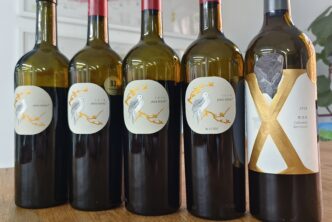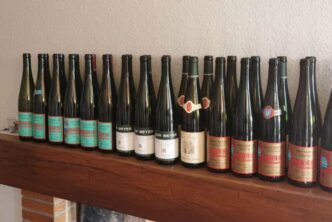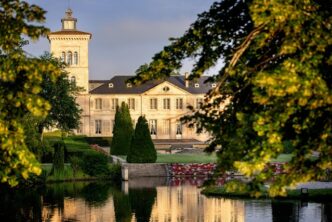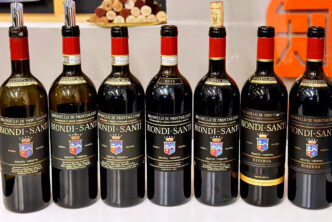In a relatively short period of time, the G.B. Burlotto winery has risen to a position of absolute prominence in the panorama of Italy’s best wineries. In fact, G.B. Burlotto’s wines were always recognized as being of very high quality, and have always been rather famous, but clearly the advent of Fabio Alessandria at the winemaking helm has helped catapult the winery to even greater fame.
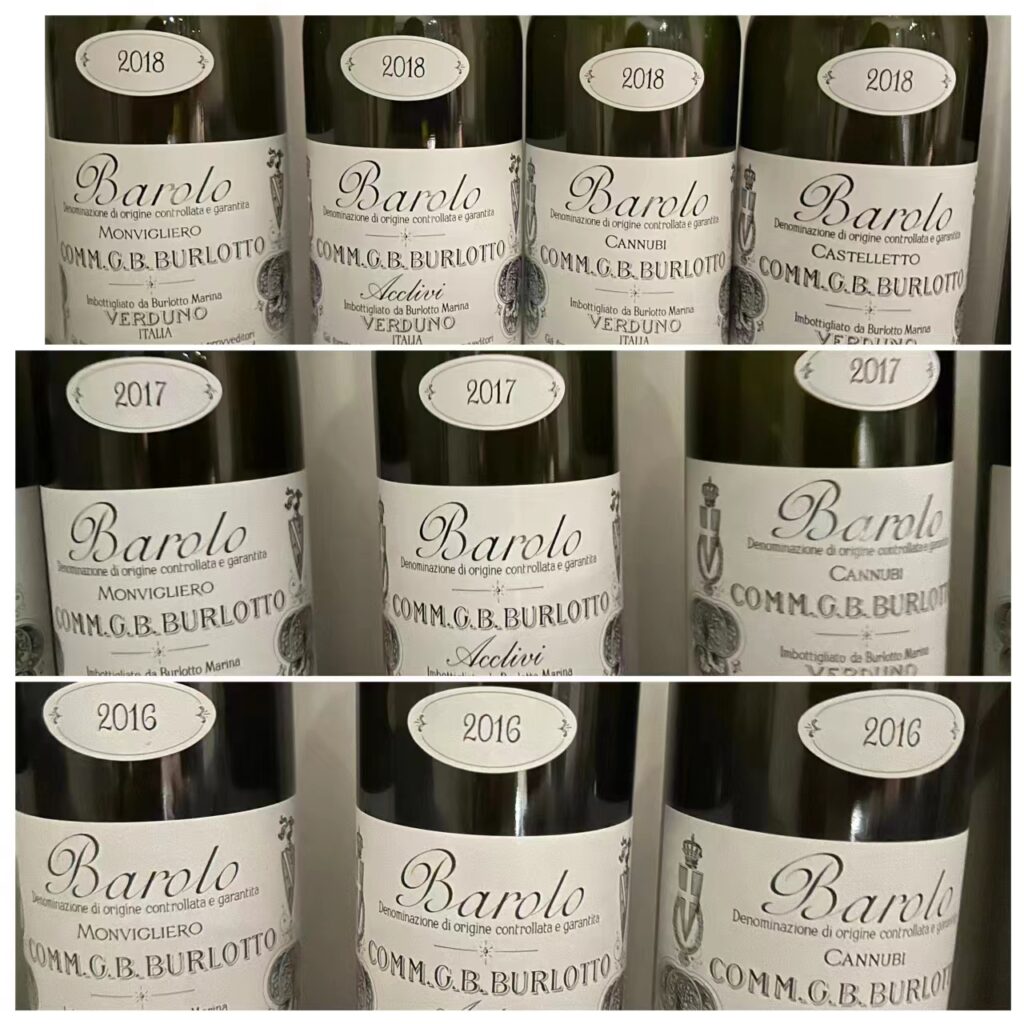
The winery was founded in 1850 and is located in the township of Verduno, one of the Barolo denomination’s eleven communes; the eighteenth-century building is easily recognizable because of the pretty thirty-two painted round medals its wines have won over the centuries that adorn the upper part of its façade as well as the winery’s bottle labels (but there in black in white). The full name of the winery is actually Comm. G.B. Burlotto: “G.B.” in G.B. Burlotto stands for Giovanni Battista (until recently a rather common first name in Italy) who was the estate’s founder. Initially, Burlotto was a “cavaliere”, but when that title was upped to “commendatore”, or “comm.” for short, the estate’s name changed too, becoming the one we know today (in Italy, “commendatore” is an honour bestowed upon civilians by the President of the Republic for services rendered to the country: it traces its roots back to the days of chivalry, meaning “knight commander” and therefore ranking just above Officer/Knight and below Grand Officer). I wasn’t kidding when I mentioned earlier that the G.B. Burlotto estate was already very famous a long time ago: in fact, it was named an official purveyor of goods to Italy’s Savoy Royal House. And in 1899, the Duca degli Abruzzi famously asked G.B. Burlotto to have its wine accompany him in his expedition to the North Pole: clearly, there aren’t too many Barolo wineries, or wineries anywhere for that matter, that can boast a similar claim to fame.
Giovan Battista was followed at the winery by his son Francesco, who died prematurely and so it was his son, Ignazio, who took over (Ignazio proved a great wine man who, among other merits, did much to save the rare Pelaverga Piccolo -also called Pelaverga Comune- variety from extinction, so we all have him to thank if today we can enjoy the lovely Verduno Pelaverga wines). When Ignazio passed away in 1968, his daughter Marina took over. Marina married Giovanni Alessandria, and had two children, Fabio and Cristina. This is why the current face of the estate, and more importantly it’s ultra-talented winemaker, is named Fabio Alessandria (and not Burlotto).
G.B. Burlotto’s Barolo vineyards
G.B. Burlotto is fortunate to own Nebbiolo vines in a number of different vineyard districts of Barolo (what some people refer to as MGAs or Menzioni Geografiche Aggiuntive). Some of these vineyard districts are more famous than others, but the estate is fortunate in that all are of very high quality (I would add that some, like Breri, are not just little-known but also a little underrated). These vineyard districts are: Boscatto, Breri, Monvigliero, Neirane and Rocche dell’Olmo in the commune of Verduno (the estate’s home base, if you will); Cannubi in the commune of Barolo (actually Cannubi Valletta, though many people in the Barolo area do their best to have you talk and speak of Cannubi in terms of one vineyard district only, which as I shall discuss shortly is both illogical and highly cheapening of this famous vineyard district); and last but certainly not least, Castelletto in Monforte d’Alba. For more in-depth and detailed information on each one of the following Barolo vineyard districts, and G.B. Burlotto’s plots owned in each, I refer you to the multiaward-winning book Barolo Terroir (Grapes Crus People Places), that I recently co-authored with Michele Longo.
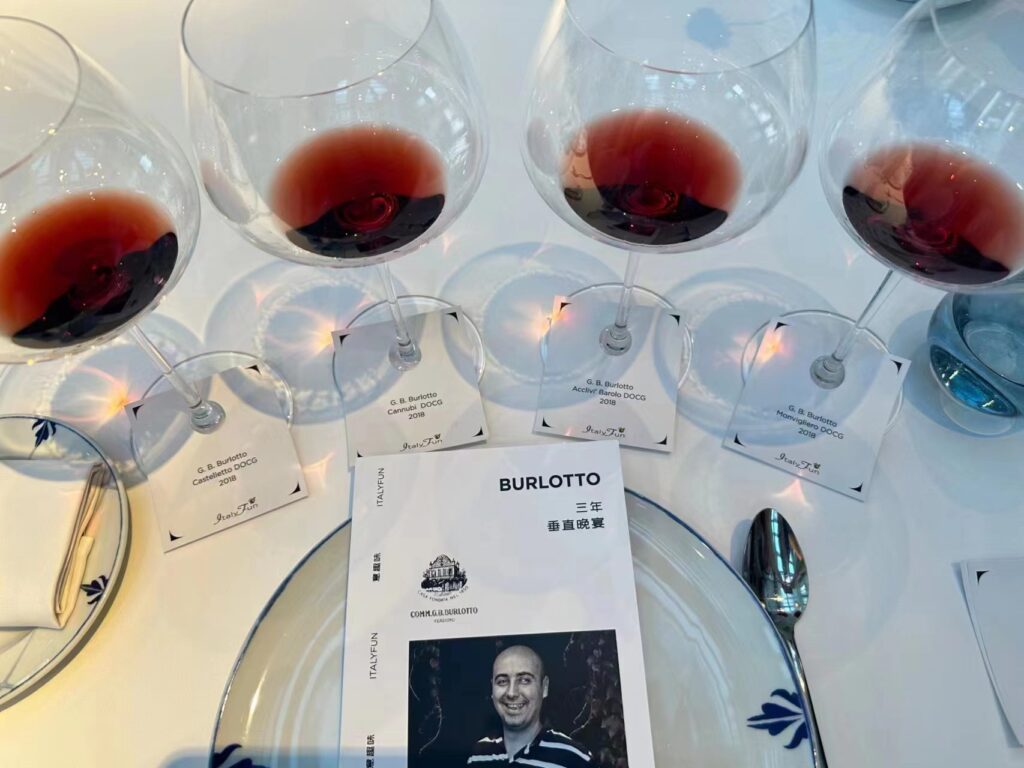
The most famous of these vineyard districts is Monvigliero, a cru the reputation of which was largely built up by the G.B. Burlotto estate. G.B. Burlotto’s Barolo Monvigliero wine is admittedly such a great wine that it led numerous other wineries to move in and/or bottle a Monvigliero Barolo, including for example Paolo Scavino, Sordo and Vietti (note that essentially nobody, outside of Verduno producers, was doing so before G.B. Burlotto’s wines shot to fame). G.B. Burlotto owns 2.02 hectares in Monvigliero divided in three plots. The vines all face south: the oldest date back to 1958, with the others planted and replanted between 1987 and 2015, on various rootstocks. Monvigliero’s soils were formed during the Messinian and Tortonian stages of the Miocene Epoch, roughly 7 to 11 Million years ago. The lithology is that of the laminated type of Saint Agatha’s Marls; in other words, Monvigliero Barolos are hauntingly perfumed and easier to approach when young, though they age remarkably well (like all Barolos, wines from this vineyard district have no trouble reaching up to forty years of age without a problem). They are the best example of Barolos from the Verduno commune, the territory of which is often misguidedly described as being highly sandy, when in fact it is much less sandy than commonly thought. The Nebbiolo grapes of the Boscatto, Neirane and Rocche dell’Olmo vineyard districts are used to make the estate’s Barolo named “Acclivi” (though in many vintages there is a small percentage of Monvigliero grapes included too): the Acclivi wine is made in the classic Barolo way of blending grapes from different vineyards so as to come up with the best possible wine in each and every vintage. In fact Acclivi, more than an embodiment of a good classic Barolo (the latter is actually best represented by the estate’s wine simply called Barolo: this is where the grapes from the 0.77 hectares parcel in Breri go), is meant to showcase Verduno’s Barolos, given that the grapes come only from Verduno vineyard districts and fairly different ones at that. Boscatto (the winery owns 1.13 hectares there), Neirane (1.1 hectares) and Rocche dell’Olmo (1.25 hectares) are all in Verduno’s territory and are more or less all characterized by a similar lithology which differs from the lithology of Monvigliero in a number of important ways (amongst which are a younger geologic origin, less limestone and different fossils). The grapes from these three sites, that differ in exposure, altitude, and topography (to be precise, they differ slightly in soil type too), complement each other well, making Acclivi a remarkably successful, very elegant and not especially powerful Barolo wine made from a blend of Nebbiolo grapes.
Over in the commune of Barolo, G.B. Burlotto owns 0.7 hectares of vines in the section of the extended Cannubi hillside known historically as Valletta or Cannubi Valletta. The vines, though not located especially high up (at around 280 meters above sea level) and recently replanted (in 1988) are however situated in the best part of the Cannubi Valletta, the one that looks straight south (and not the section that curves forming the small valley that gives this part of Cannubi its name).The estate’s wine, just like the Cannubi wines of most other wineries nowadays, only carries the Barolo Cannubi designation on its label without any mention of Valletta, which the law allows. But as I have said and written numerous times before and have described and documented at length in the aforementioned book Barolo Terroir (Grapes Crus People Places) book, the various sections of the long Cannubi hill (Cannubi Boschis, Cannubi Centrale, Cannubi Valletta, Cannubi San Lorenzo and Cannubi Muscatel) present enough differences in altitudes, exposures, and soil that the wines of each are recognizably different too. For this reason it would have made more sense to identify the Barolos from each of these Cannubi subregions as such. After all, you don’t see them in Burgundy allowing everybody to call their wine Montrachet only, or just Chambertin, right? No, of course not: instead, they make very clear distinctions between the areas and the wines of Bâtard-, Chevalier-, Bienvenues-Bâtard-, and Criots-Bâtard-Montrachet from Montrachet proper, just as they do with Charmes-, Chapelle-, Griotte-, Mazis-, Clos-de Bèze and Chambertin proper. Frankly, as much as it might be painful to admit, if French wines have a better reputation and fetch higher prices than even Italy’s most famous, well, it’s not so hard to understand as to why that may be. All that notwithstanding, Cannubi Valletta, like all the sections of Cannubi, gives exceptional wines, some of Barolo’s very best, and it is no different with the Barolo Cannubi wine made by G.B. Burlotto: in fact, it has always been my belief that this specific bottling’s star shines a little less brightly than it should, seeing as it is “forced” to share the spotlight with the currently hotter-than-hot Monvigliero. But make no mistake about it, G.B. Burlotto’s Barolo Cannubi is a splendid wine. And with the 2018 vintage, G.B. Burlotto released its first ever Barolo from the Monforte commune’s Castelletto vineyard district. There they own about 1.07 hectares between 270 and 300 meters above sea level (for the time being at least, the estate is making their Barolo Castelletto only from the upper part of their vineyard holding, planted in 1973). This part of the Barolo denomination is radically different from that of the Barolo and Verduno townships in many respects, leading to Castelletto’s wines being far more austere and tannic in their youth than those made in the Barolo and Verduno communes. This is even more so with G.B. Burlotto’s version of Barolo Castelletto, because the winery’s vines are planted in the eastern section of the Castelletto vineyard district that looks towards Serralunga d’Alba, an area characterized by Lequio Formation lithology (compacted sands and marls with high percentages of limestone) that give wines that have much more in common with those of the Serralunga commune. Even in a difficult vintage such as 2018, G.B Burlotto made a truly outstanding wine from this site: se il buongiorno si vede dal mattino, as they like to say in Italian, the winery has reason to be very happy. I think they bought themselves a real winner here.
A few short words about the winemaking and the wines
Much has been made about Fabio Alessandria’s use of whole bunches, in the manner of Pinot Noir and Burgundy. In fact, the only Barolo for which this technique is implemented is the Barolo Monvigliero. That led some writers and even some of Alessandria’s colleagues to believe and state that the secret of G.B. Burlotto’s Barolo Monvigliero wine was really the use of whole bunches, and that Monvigliero itself had little or no specific merits. I always viewed this as an erroneous way of thinking: this because at almost any winery that was making a Monvigliero Barolo, or vinified its grapes individually to then blend them with those from other sites so as to make a classic Barolo blend, it was immediately obvious to anyone (and certainly to me) that the Monvigliero wine was always the best, or at no worse one of the three best, wines the estate was making. So the quality of G.B. Burlotto’s wine could not be reduced to “just” the use of whole bunches, because many of the other estates weren’t using them at all (see: Barolo Terroir : Grapes Crus People Places. All the other Barolos from G.B. Burlotto are made with destemmed grapes. All the wines age about 20-33 months (depending on the vintage) in large French oak barrels, while the Monvigliero can age up to a year longer, and in large barrels of both French and Slavonian oak.
I want to underscore how this report focuses on G.B. Burlotto’s many fine Barolos, but in fact this is -easily-one of Italy’s fifty best wine estates and all its wines are noteworthy, amongst the best of their class. For example, you will be hard-pressed to find a better Freisa wine than G.B. Burlotto’s, and the winery’s Verduno Pelaverga wine is also arguably the best one made today. Unfortunately, both these wines are made in small volumes, but the Dolcetto and Barbera wines are top-notch too. Clearly, it’s Fabio Alessandria’s Barolos that wine lovers and collectors pine for all over the world, but I would urge you to also give G.B. Burlotto’s other wines a try, especially the Verduno Pelaverga and the Freisa that really are amongst Italy’s best red wines too.
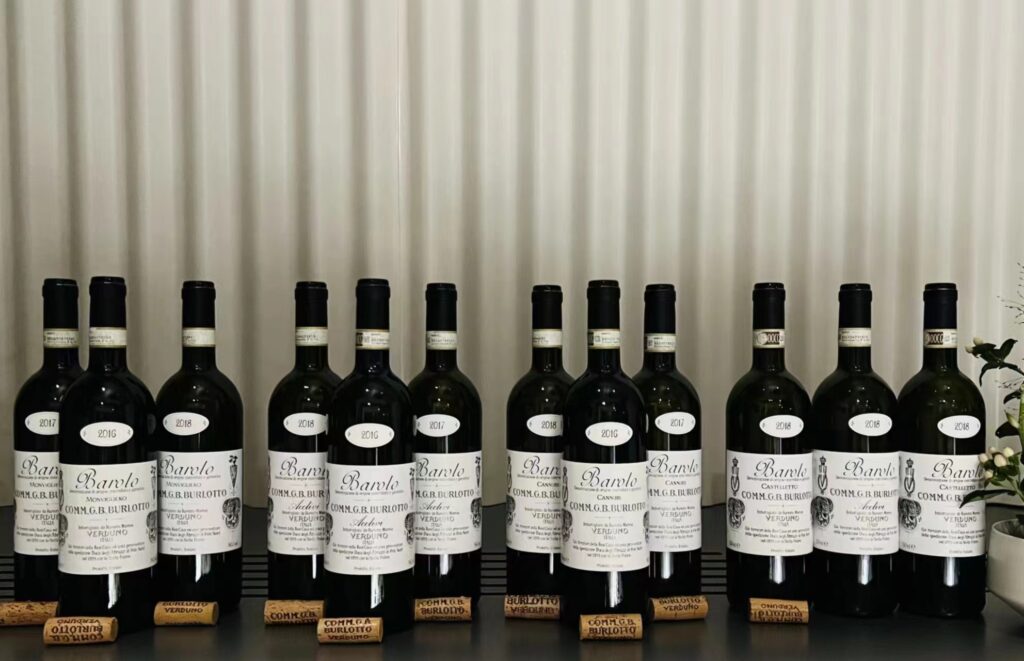
The wines in this tasting
All the wines in this tasting were tried in non-blinded fashion during a tasting that preceded dinner at New Wave restaurant, the high-end bistro of the Cerea family of the Da Vittorio three Michelin star in Brusaporto, Italy and other much awarded dining establishments all over the world. The evening was brilliantly organized by Tony Chan, manager and owner of the Italyfun Importing company, to whom go my thanks for making these wines available.
G.B. Burlotto 2018 Barolo Acclivi 95
Full, deep red colour. Enticing lift to the rather Burgundian aromas of dark and red berries, black cherry, licorice, cinnamon, and star anise, complicated by hints of balsamic oils and earth tones. Suave, juicy and fresh in the mouth, with plenty of easy-drinking charm but also sneaky concentration to its sweet dark red fruit and herb flavours. Finishes with a fine tannins and outstanding floral length. Very easy to drink now, but actually has the stuffing to develop further. Burlotto’s Barolo Acclivi is often underrated compared to its more famous Monvigliero and Cannubi stablemates, but the 2018 is an outstanding Acclivi and speaks to the importance of being able to blend grapes from different sites in difficult vintages (Acclivi is a blend of Nebbiolo from the Neirane, Boscatto and Rocche dell’Olmo vineyard districts). It also speaks to the talent of winemaker Fabio Alessandria who is able to make truly remarkably good Barolos even in vintages like 2018. To be crystal-clear, this is one of the better Burlotto Barolos of 2018, but I fear many will have missed out on it in their kneejerk reflex-type search for Burlotto’s more famous Monvigliero and Cannubi bottlings. Drinking window: 2025-34 for maximum drinking enjoyment, but will last longer in a good cellar.
G.B. Burlotto 2017 Barolo Acclivi 93
Medium dark red. Red berries, tobacco, herbs, and dried flowers on the slightly aromatically compressed nose. Juicy, fresh and light-bodied, this could use a bit more sweetness and flesh to its herbal red berry flavours. Closes long but a little simply, with slightly leathery, tough tannins and very good grip. Drinking window: 2027-37.
G.B. Burlotto 2016 Barolo Acclivi 94+
Good deep red. Currently reticent dark cherry, blueberry, blood orange, sage, and mint aromas, that perk up with aeration thanks to pretty floral and pomegranate elements. Offers plenty of inner-mouth perfume to its solid flavours of sour red cherry, dark licorice and balsamic oils, nicely supported by the tannic backbone typical of the 2016 vintage that becomes especially evident in Barolos from sites with a slightly sandier composition (though I caution readers that the territory of the Verduno commune is not nearly as sandy as is commonly written). The aftertaste is suave and smooth, boasting outstanding subtle concentration and length. This beautiful wine will age remarkably well, and I hope it will develop further complexity with bottle age, hence the “+” sign on my score; in that case the 2016 Acclivi will turn out to be a 95-96 point wine. Drinking window: 2026-42.
G.B. Burlotto 2018 Barolo Monvigliero 94
Good full bright red. Musky, slightly medicinal aromas of raspberry, camphor, red licorice and menthol, complicated by hints of truffley underbrush have a somewhat limited range for what is normally an explosively, deeply perfumed wine. Juicy and broad in the mouth, with a restrained sweetness and limited complexity to the flavours of red fruits, pine cone, cherry cola, candied rose petal, and orange peel. The 2018 Monvigliero from Burlotto is nicely round and light on its feet, but I would have liked a bit more depth and concentration. It’s a very pretty wine, but slightly less thrilling than I am accustomed to with what is, quite rightly, one of Italy’s most famous red wines; and though it is likely to develop greater nuance in time, I doubt it will ever lose its slightly sullen personality. Given how difficult to find this wine is, and the considerable expense it now takes to buy a bottle, my advice is to buy Burlotto’s Barolo Acclivi and Cannubi in 2018. Trust me, you’ll thank me later. Drinking window: 2027-42.
G.B. Burlotto 2017 Barolo Monvigliero 96
Good bright red. Musky cherry, mint, sage, gingerbread, peony, rhubarb and dried rose on the complex, deep nose, lifted by a whiff of blood orange. Enters silky-sweet and graceful, then showcases a mineral firmness in the middle, and underlying, rising plush strawberry fruit and spice flavours on the long, polished finish. This impressively deep, classy, scented Barolo offers excellent subtle persistence and is a masterful result in what was one of the toughest Barolo vintages of the last thirty years. Talented winemaker Fabio Alessandria opted to use selected yeasts in this vintage because of the heat, and in fact the grapes were picked relatively early in the year (at the end of September). It is without question the best Barolo Fabio Alessandria made in 2017. Drinking window: 2025-42.
G.B. Burlotto 2016 Barolo Monvigliero 98
Moderately saturated bright red. Knockout nose suggests red cherry, apricot, red licorice, grilled herbs, pistachio, orange peel, graphite, and botanical herbs, with an undertone of red rose and violet. Classically dry, even austere currently, and very precisely delineated, this conveys at once plenty of focus and energy coupled with great delicacy. Closes minerally with very good ripeness of fruit, and is virtually weightless, not to mention extremely long. Clearly an outstanding wine that will develop even greater nuance and complexity in the years to come. Drinking window: 2028-46.
G.B. Burlotto 2018 Barolo Cannubi 97
Good full, deep, luminous red. Perfumed, deep, high-pitched aromas of sour red cherry, redcurrant, rose petal, minerals and violet, lifted by a balsamic component; this struck me as being quite Burgundian. In the mouth, it’s at once broad, suave, and silky, but also powerful and concentrated but without any undue weight. Extremely refined, Burlotto’s 2018 Barolo Cannubi is a masterpiece that really saturates the palate with really lingering perfumed nuances of sweetly spicy redcurrant, mocha and candied violet. A remarkably great wine given how difficult it was to achieve similar results in 2018 for most everybody else, this gorgeous Barolo manages the neat trick of being broad and accessible but at the same time also elegant and deep. And though very drinkable right now, it has the juicy acidity, glossy fruit and firm tannic spine needed to support a slow and successful evolution in bottle. It’s wines like these that place the importance of terroir clearly in perspective: while it’s easy to knee jerk and automatically assume that Monvigliero is always Burlotto’s best Barolo of the year, that is a simply lazy and nonsensical way of writing about wine: rather, the sandy-clay nature of the Cannubi Valletta where Burlotto owns its Cannubi vines (actually, Cannubi Valletta is a part of Cannubi that is not as sandy as are the Cannubi San Lorenzo and the Cannubi Centrale) gave this site a distinct advantage over the Verduno holdings in 2018, and it is only logical that it would have been so. The Cannubi is Burlotto’s best Barolo of 2018. Drinking window: 2026-46.
G.B. Burlotto 2017 Barolo Cannubi 94
Good deep red. The deep nose combines red- and blackcurrant, mint, anise, pipe tobacco, cocoa and minty herbs with a whiff of flowers. Big, rich and savory, with saline and mineral flavours more than primary fruit. The finish is long but mountingly tannic. For the same reasons that the Cannubi Valletta portion of Burlotto’s holdings in Barolo were favoured in 2018 they were at a disadvantage in 2017. Drinking window: 2027-40.
G.B. Burlotto 2016 Barolo Cannubi 100
Good deep, bright red. Complex, varietally expressive aromas of sour red cherry, dried rose and violet petals, sweet spices and marzapan. Suave and fine-grained, with a silky texture and a strong impression of soil-driven extract to the very deep unusually dark fruit and balsamic flavours. A remarkably and somewhat unexpectedly brooding and powerful Barolo from Cannubi Valletta, but with the site’s tell-tale elegance. Finishes very complex, sappy and long, with extremely fine-grained tannins. Multifaceted and with a very long life ahead of it, this is an ode to all that makes Nebbiolo and Barolo great. Drinking window: 2028-46.
G.B. Burlotto 2018 Barolo Castelletto 97
Saturated deep red. Very sexy aromas of strawberry, sour red cherry, redcurrant, underbrush, cherry cola, and dried flowers, plus a whiff of cocoa. Densely packed, suave and fine-grained, with lovely inner-mouth energy provided by citrussy acidity giving the steely red fruit, blood orange and mineral flavours a steely quality. Finishes long, with utmost clarity and cut, and a palate-coating but polished tannic quality and suggestions of minty austerity. A knockout example of Monforte Barolo that speaks very clearly of the Lequio Formation soils of this part of Castelletto (where G. B. Burlotto owns its Castelletto Nebbiolo vines) a part of Monforte that gives wines completely different from most of those of, for example, Ginestra and Mosconi, two other famous Monforte crus. This is the first vintage ever of the Castelletto Barolo made by Burlotto, and it is an absolute winner. The estate chooses to use only the Nebbiolo planted back in 1973 in the upper half of their holdings to make this wine, and it strikes me as it was a very good choice. Very, very well done. Drinking window: 2028-46.
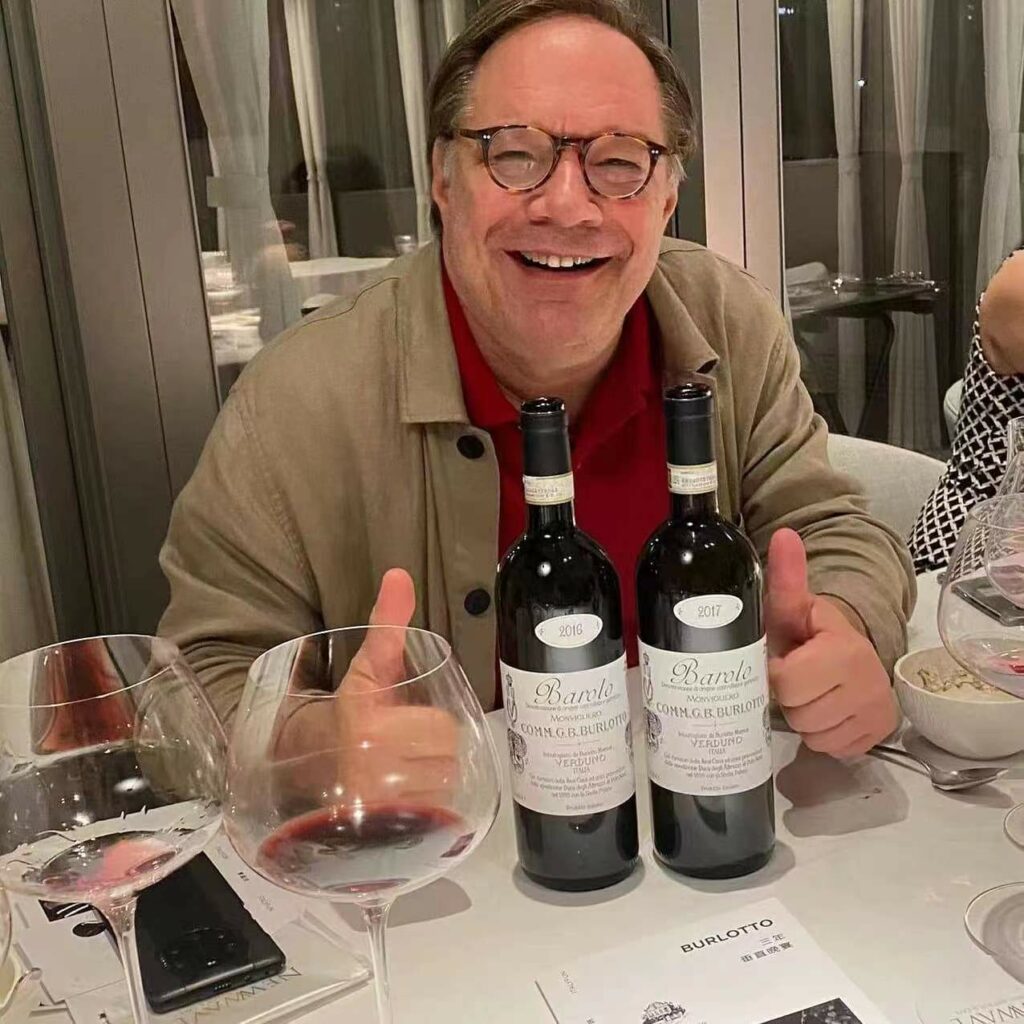

 中文
中文
